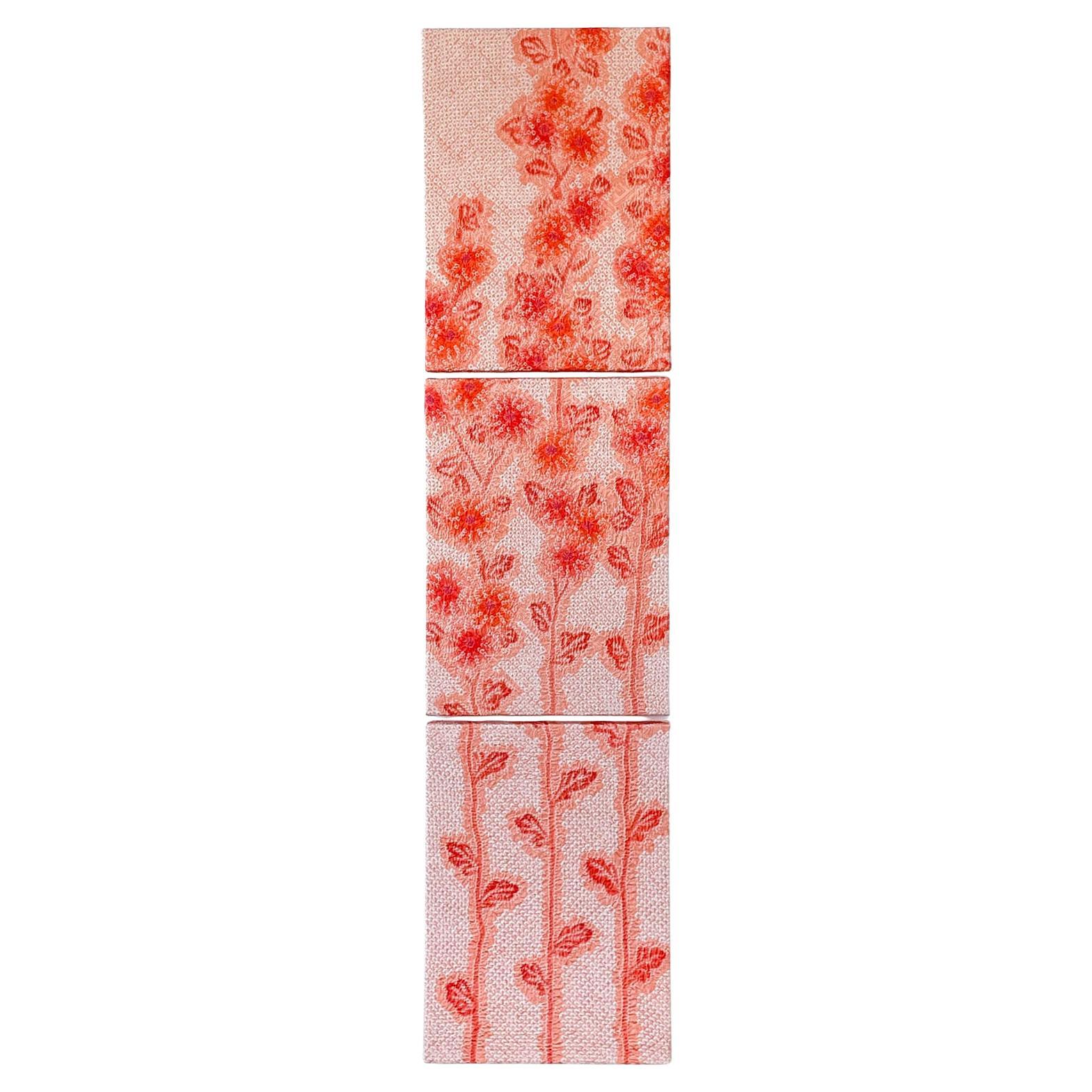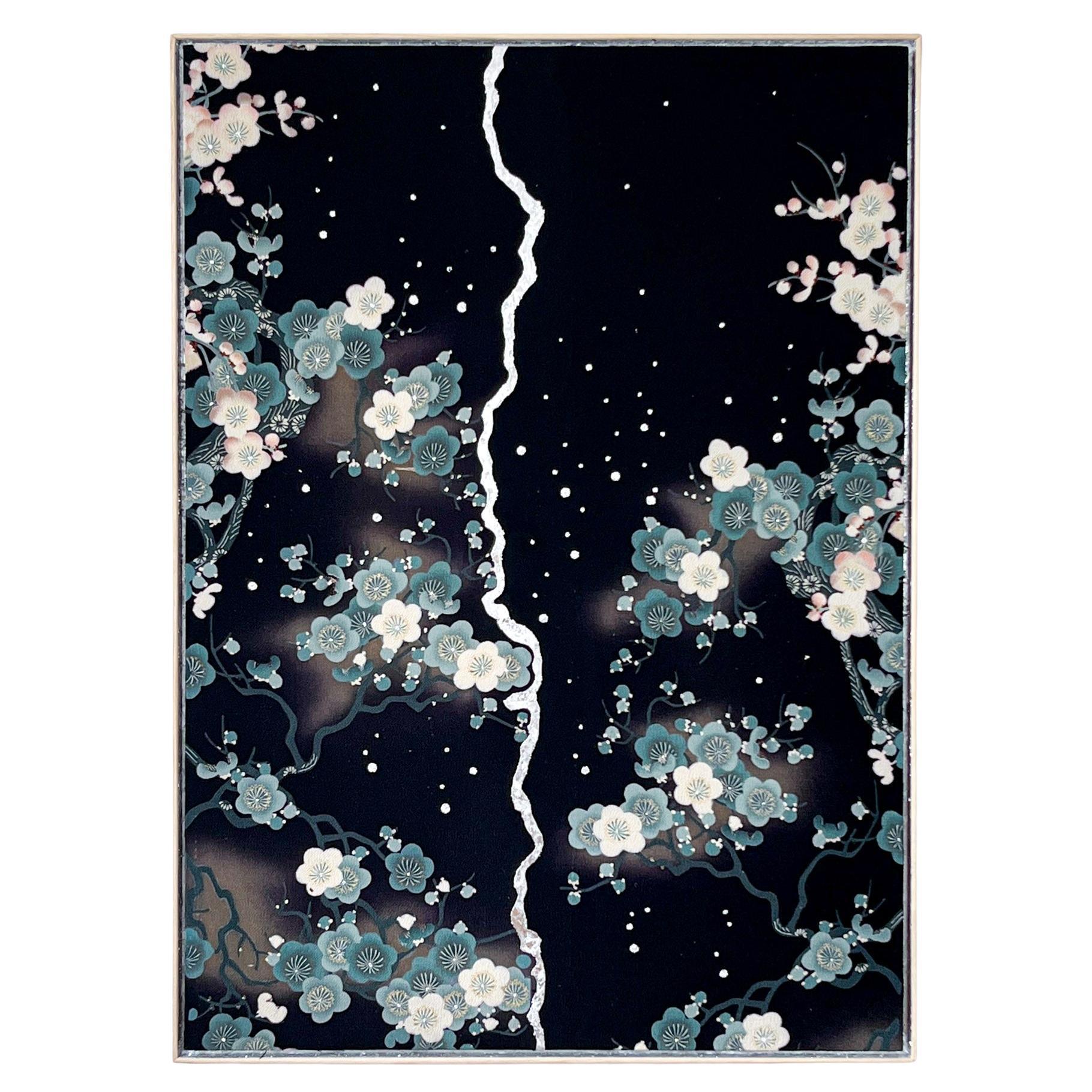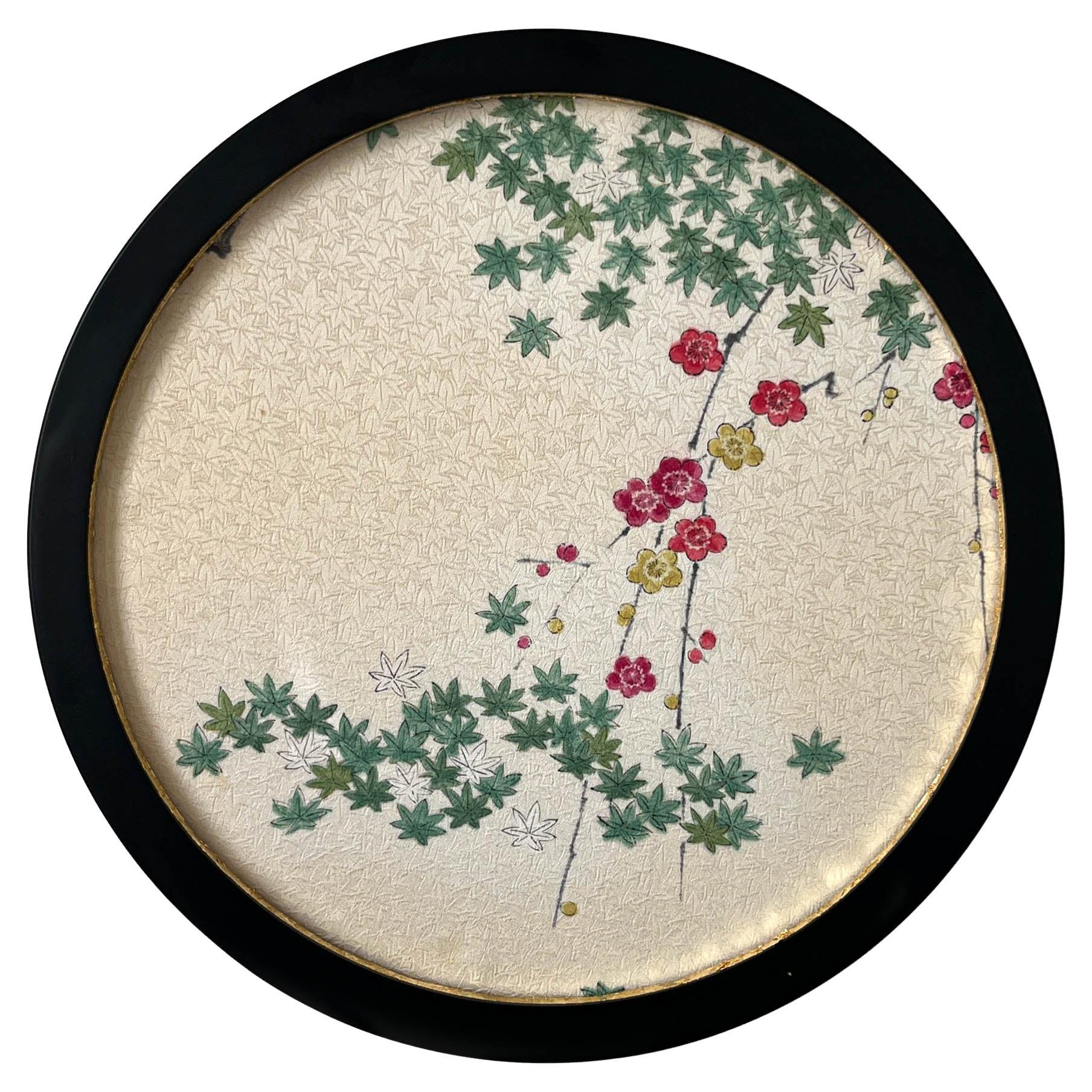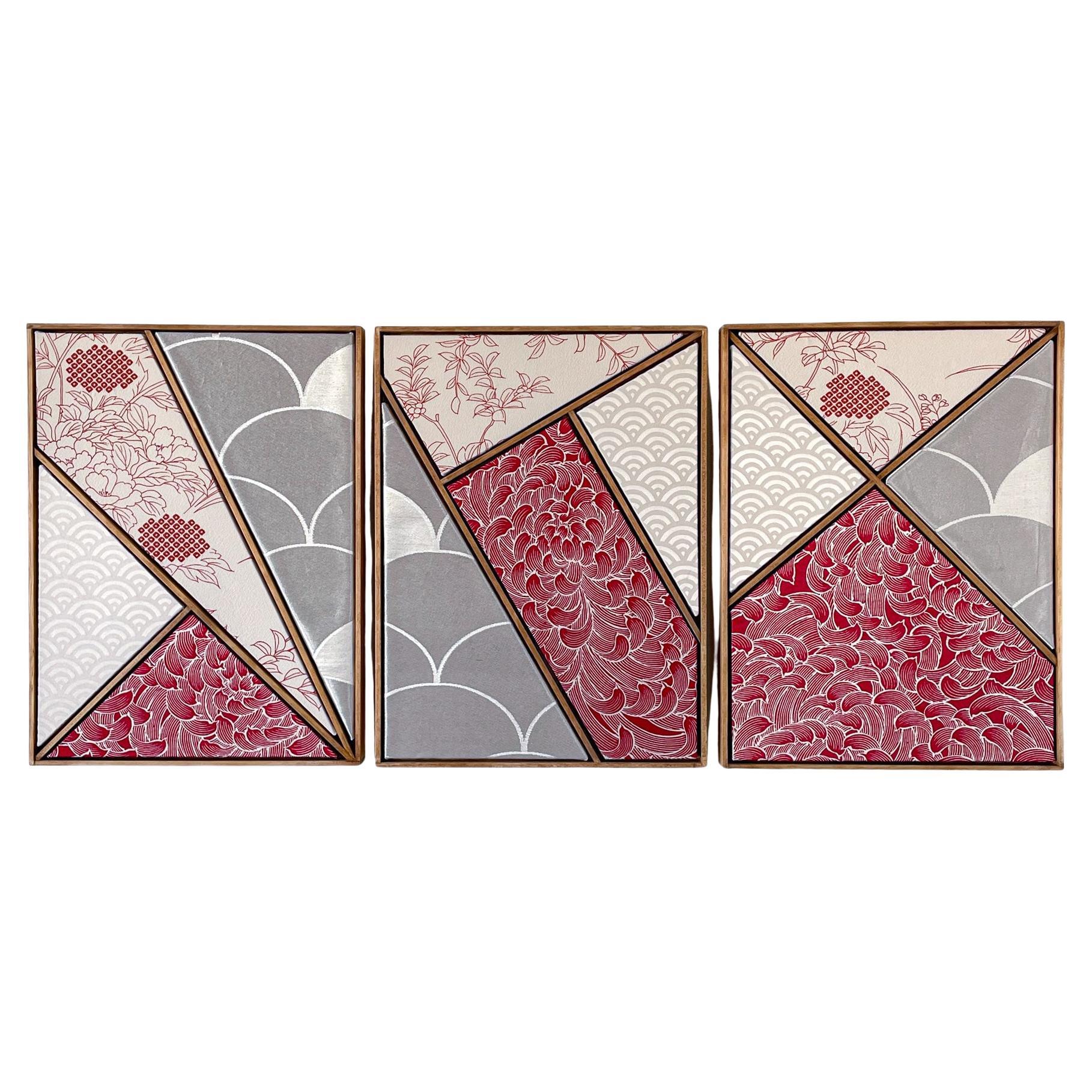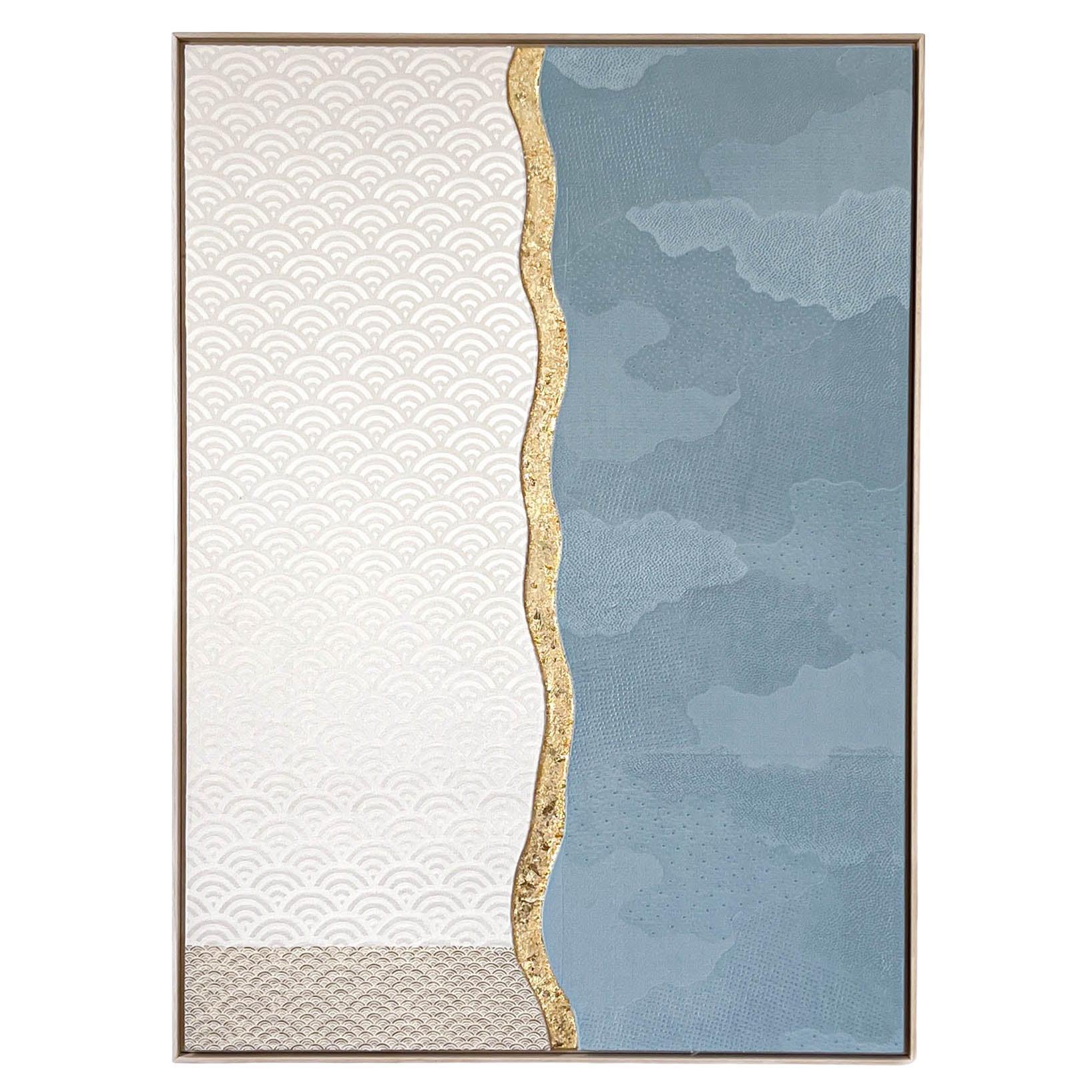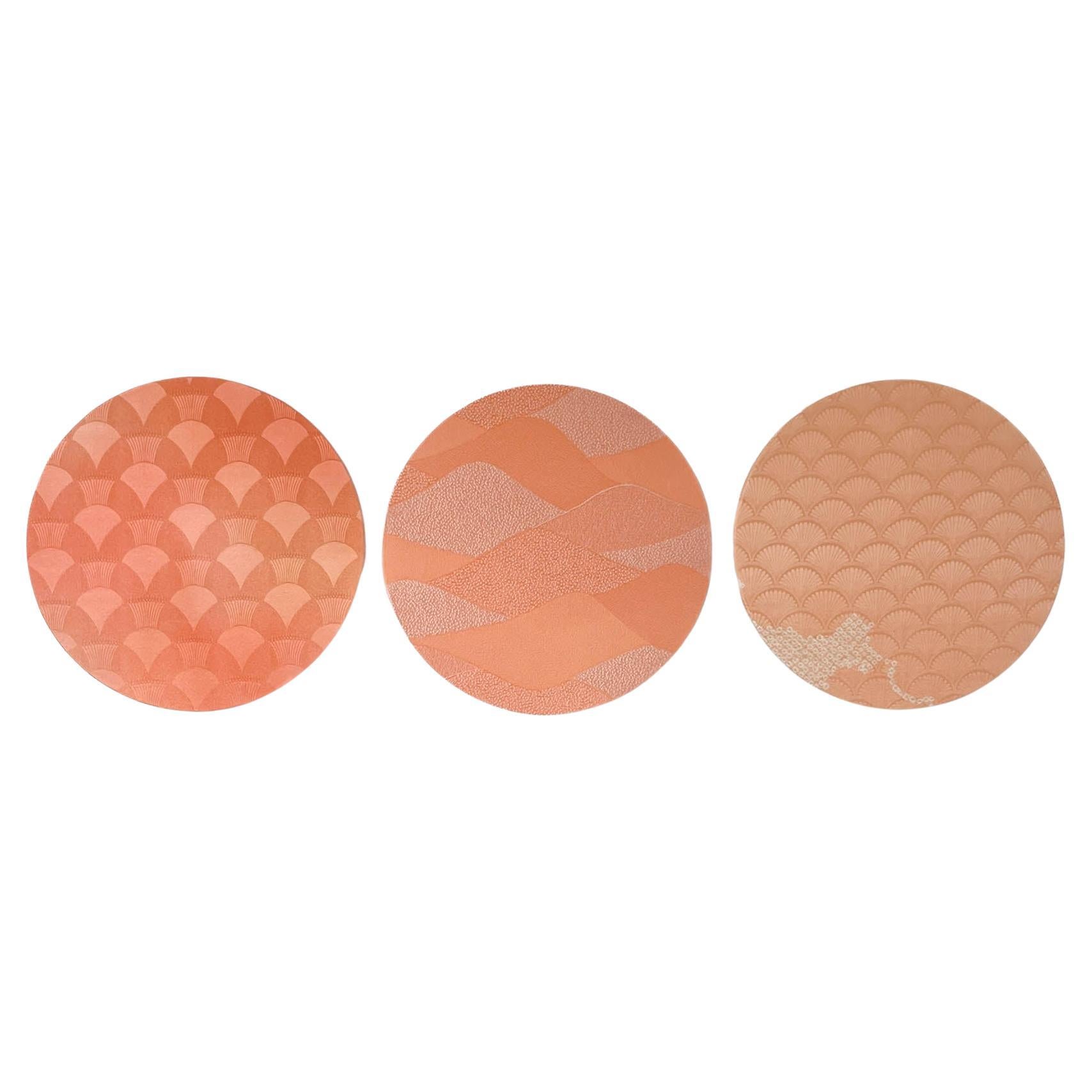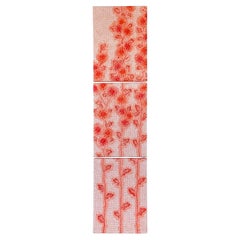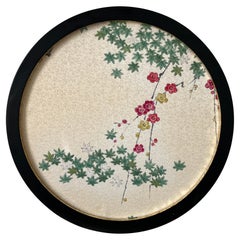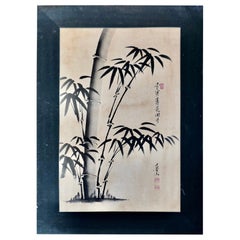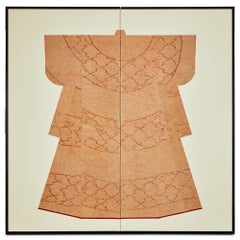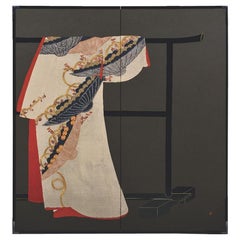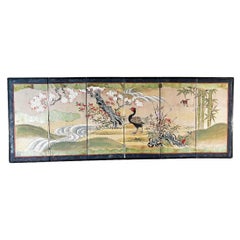Items Similar to Vintage kimono textile art " Plum Gradation " by ikasu Pink, White, Japan
Want more images or videos?
Request additional images or videos from the seller
1 of 21
Vintage kimono textile art " Plum Gradation " by ikasu Pink, White, Japan
About the Item
This canvas featuring a plum color gradient kimono showcases a unique decorative variation of the popular seigaiha (青海波) sea waves pattern.
The artwork got a Mr. & Mrs. Abe Arts & Culture Prize in 2024.
<< Period/Story >>
This canvas is made from upcycled kimono from the late Showa period, likely from around the 1980s.
<< Explanation and meaning of pattern and colors >>
The decoration designed on the ocean waves pattern resembles peacock feathers, adding an oriental ambiance to this unique pattern.
The ocean waves are regarded as an auspicious motif, with endless waves symbolizing a desire for everlasting happiness and a peaceful life for those who possess it.
<< Description of fabric characteristics >>
This piece features a decorative ocean wave pattern known as "Seigaiha," created through a weaving technique called "jimon." In this technique, the pattern emerges not from colors but from the way light reflects off threads at various angles.
In kimono culture, the lining that peeks out from the sleeves and bottom is known as "hakkake." It offers a unique way to appreciate colors and patterns. Sometimes, these rarely seen parts, visible only when the wind blows or while walking, turn out to be the most beautiful in entire kimono. This embodies the concept of "uramasari," a tradition of being "secretly awesome." This canvas is an upcycled version of the hakkake - the kimono lining.
While plain fabrics have become common for hakkake in recent years, this one uses a fabric with a woven pattern, highlighting the meticulous attention to details of the person who originally crafted it.
- Creator:Kimono ikasu (Artist)
- Dimensions:Height: 0.79 in (2 cm)Diameter: 11.82 in (30 cm)
- Style:Japonisme (In the Style Of)
- Materials and Techniques:
- Place of Origin:
- Period:1980-1989
- Date of Manufacture:1980ies
- Condition:
- Seller Location:Setagaya City, JP
- Reference Number:1stDibs: LU10079243793872
About the Seller
New to 1stDibs
Joined in the past six months.
No Reviews Yet
Vetted Professional Seller
Every seller passes strict standards for authenticity and reliability
1stDibs seller since 2024
- ShippingRetrieving quote...Shipping from: Setagaya City, Japan
- Return Policy
Authenticity Guarantee
In the unlikely event there’s an issue with an item’s authenticity, contact us within 1 year for a full refund. DetailsMoney-Back Guarantee
If your item is not as described, is damaged in transit, or does not arrive, contact us within 7 days for a full refund. Details24-Hour Cancellation
You have a 24-hour grace period in which to reconsider your purchase, with no questions asked.Vetted Professional Sellers
Our world-class sellers must adhere to strict standards for service and quality, maintaining the integrity of our listings.Price-Match Guarantee
If you find that a seller listed the same item for a lower price elsewhere, we’ll match it.Trusted Global Delivery
Our best-in-class carrier network provides specialized shipping options worldwide, including custom delivery.More From This Seller
View AllVintage kimono textile art " Growing ~ Longevity ~ " by ikasu Pink, Japan
By Kimono ikasu
Located in Setagaya City, JP
<< About this canvas >>
This set is a depiction of a tall chrysanthemum stem, entirely dyed in a traditional shibori technique.
<< Period / Story >>
The haori featured in this canvas was created and used during the late Showa period (1960-80ies).
<< Explanation and meaning of pattern and colors >>
A charming chrysanthemum flowers all around a stem seem to reach the heavens.
The chrysanthemum flower, which retains its vitality long after being cut, symbolizes longevity, purification from malevolent spirits, and good fortune. In ancient times, during the Kamakura period (1185-1333), emperors loved the chrysanthemum pattern, and it remains the most prestigious flower and the emblem of the Japanese imperial family...
Category
Vintage 1970s Japanese Japonisme Paintings and Screens
Materials
Canvas, Silk
Antique kimono textile art " Plum Blossom Night ~Resilience~ " by ikasu Japan
By Kimono ikasu
Located in Setagaya City, JP
This artwork uses antique fabric from Taisho era (early 1920ies) kimono and paulownia wood taken from antique kiritansu - chest-of-drawers used initially to keep kimonos.
It is eleg...
Category
Vintage 1920s Japanese Japonisme Paintings and Screens
Materials
Silver Leaf
Vintage kimono textile art "View from the Window ~Maple&Plum~" by ikasu, Japan
By Kimono ikasu
Located in Setagaya City, JP
This work is a glorious nod to buddhist temples circle windows, with beautiful Japanese garden scape seen outside. Golden leaf on the border of a frame is an expression of light goin...
Category
Vintage 1930s Japanese Japonisme Paintings and Screens
Materials
Gold Leaf
VIntage kimono textile art "Geometry ~Chrysanthemums" by ikasu, white, red Japan
By Kimono ikasu
Located in Setagaya City, JP
This work is inspired by traditional Japanese natural symbolism, and is framed in paulownia wood originally used for a kimono chest-of-drawers.
It is elegantly framed with paulownia...
Category
Vintage 1960s Japanese Japonisme Paintings and Screens
Materials
Silk, Wood
Vintage kimono textile art " Seaside ~ Kintsugi ~ " by ikasu White/Blue Japan
By Kimono ikasu
Located in Setagaya City, JP
This work is inspired by the sea and the sky, uses golden leafing as a creative point, framed in paulownia wood originally used for a kimono chest-of-drawers.
In this artwork, the aim was to capture the splendor of Japanese nature, showing the sea, sky, and forests. Traditional Japanese culture, represented by the kimono, and wood, an integral element of Japanese craftsmanship, were used to bring this vision to life.
I used two pieces of kimono that could no longer be used as clothing and bark that would normally be discarded to create the ultimate upcycled piece.
The marriage of Japanese natural materials - silk, paulownia (frame), and pine (branch slices for the center decoration) - and Japanese natural patterns - blue ocean waves and clouds - expresses the magnificent beauty of Japanese nature from various angles.
The central golden leaf decoration stands out as a distinctive feature of this work. The piece uses the concept of "kintsugi" - it "unites" the pieces of antique kimono back together with golden leaf to give it a second wind as art work.
<< Period / Story >>
The kimono used in this piece was originally crafted during the late Showa period (1960-80ies).
<< Explanation and meaning of pattern and colors >>
The kimonos on this canvas have been creatively repurposed into interior artwork. The one on the left represents ocean wave pattern.
Seigaiha waves is regarded as a pattern of good fortune, embodying wishes for eternal happiness and a tranquil life for future generations.
The fabric on the right is embellished with cloud patterns woven in various techniques. Clouds, with their ever-shifting shapes and colors, have long intrigued people as signs of big events or omens.
<< Characteristics of the fabric >>
The kimono used for a part on the left has a lustrous, ivory-colored ground that serves as a backdrop for the vibrant ocean wave pattern expressed through the ground pattern.
On the right fabric, the cloud pattern is beautifully rendered by dyeing both the plain fabric and delicate patterns. This is achieved through the so-called "Yose-komon" technique, where each cloud is adorned with small patterns such as hail, sharks skin pattern, and other intricate details.
Edo komon, created using a refined and advanced dyeing technique that appears as a solid color from a distance, originated during the Edo period (1603-1868) and remains highly popular as formal kimono attire to this day.
<< About the frame >>
Kiritansu - chest-of-drawers for kimono, is traditionally made from paulownia wood, a uniquely Japanese material closely tied to the world of kimonos.
Paulownia wood is known as the lightest wood in Japan, prased for its natural luster, resistance to moisture, and resilience against cracking. Since ancient times, it has been used in crafting furniture, chests, and musical instruments.
During the Edo period, it became customary to store cherished kimonos in paulownia chests...
Category
Late 20th Century Japanese Japonisme Paintings and Screens
Materials
Gold Leaf
Vintage kimono textile art "On Coral Waves ~Everlasting~" by ikasu Pink, Japan
By Kimono ikasu
Located in Setagaya City, JP
<< About this canvas >>
This kimono canvas set of three pieces portrays mountains surrounded by the sea. While each of the three pieces is crafted from different kimonos, they all s...
Category
Vintage 1970s Japanese Japonisme Paintings and Screens
Materials
Silk, Canvas
You May Also Like
Vintage Bamboo Japanese Art, Wall Art 5 excellent pieces
Located in Chillerton, Isle of Wight
Vintage Bamboo Japanese Art, Wall Art
5 excellent pieces, on cartridge paper set on Black Silk
Wonderful Vintage pieces, from 1980, 21.5” high, 15.5” wide
ZX281
Category
Vintage 1980s Japonisme Paintings and Screens
Materials
Paper
Japanese Two Panel Screen: Kimono
Located in Hudson, NY
Beautiful 19th century shibori (pin dyed) fabric in kimono form mounted on a simple ground of mulberry paper. Black lacquer trim with beautifully designed bronze mounts. The fabric ...
Category
Early 20th Century Paintings and Screens
Materials
Fabric, Wood, Lacquer, Paper
Japanese Contemporary Red Black Cream Folding Screen Silk Brocade Kimono Art, 3
Located in Takarazuka, JP
Exceptional Japanese contemporary two panel "byobu" or folding screen featuring genryoku style handcrafted silk raised kimono Japanese decorative art in crimson red, black and gold o...
Category
21st Century and Contemporary Japanese Meiji Paintings and Screens
Materials
Gold
Japanese Birds, Bamboo, And Plum Tree Summer Time Screen
Located in South Burlington, VT
Just acquired in Kyoto, Japan
A suumer time treat as this rendered smaller scale Japanese six-panel folding screen byobu was conceived in this convenient size 18 inches high and 4...
Category
Early 20th Century Japanese Meiji Paintings and Screens
Materials
Paper
17th Century Japanese Screen. Ink Plum Tree & Birds by Kano Naonobu.
Located in Kyoto, JP
Kano Naonobu (1607-1650)
Plum Tree and Birds
Six-fold Japanese Screen. Ink and slight color on paper.
In this evocative ink work spread over a six-panel folding screen, we see the consummation of the elegance and refinement of the Edo Kano school. This 17th century screen is a rare surviving example of a large-scale bird and flower painting by Kano Naonobu, the younger brother of Kano Tanyu...
Category
Antique 17th Century Japanese Edo Paintings and Screens
Materials
Wood, Paper
Japanese Six-Panel Screen, Winter Landscape with Flowering Plum
Located in Hudson, NY
Japanese six-panel screen: Winter landscape with flowering plum, Meiji period (1868-1912) painting of a full moon with wild grasses between river's edge and a snow covered plum tree ...
Category
Early 20th Century Japanese Meiji Paintings and Screens
Materials
Gold Leaf
Recently Viewed
View AllMore Ways To Browse
Japanese Kimono
Japanese Used Kimono
Japanese Weaving
Vintage Fabric Screen
Japanese Art Ocean
Arts And Crafts Screen
Kimono Sleeve
Vintage Peacock Art
Vintage Kimonos
Oriental Screen
White Kimono
Pink Peacocks
Vintage Kimono Japan
Japanese Kimono Fabric
Upcycle Vintage
Vintage Orientalize Painting
Upcycle Vintage Furniture
Vintage Kimono Fabrics
